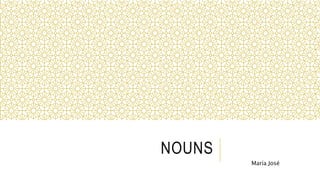
Nouns
- 2. WHAT IS A NOUN? A noun is a word that names something: either a person, place, or thing. In a sentence, nouns can play the role of subject, direct object, indirect object, subject complement, object complement, appositive, or adjective.
- 3. TYPES OF NOUNS Nouns form a large proportion of English vocabulary and they come in a wide variety of types. Nouns can name a person: Example: Albert Einstein Example: the president Example: my mother Example: a girl Nouns can also name a place: Example: Mount Vesuvius Example: Disneyland Example: my bedroom
- 4. TYPES OF NOUNS Nouns can also name things, although sometimes they might be intangible things, such as concepts, activities, or processes. Some might even be hypothetical or imaginary things. Example: shoe Example: faucet Example: freedom Example: The Elder Wand Example: basketball
- 5. PROPER NOUNS VS. COMMON NOUNS Proper nouns. One important distinction to be made is whether a noun is a proper noun or a common noun. A proper noun is a specific name of a person, place, or thing, and is always capitalized. Example: Does Mary is bored this quarantine? Mary is the name of a specific person. Example: I would like to visit Disneyland. Disneyland is the specific name of a geological phenomenon.
- 6. PROPER NOUNS VS. COMMON NOUNS Common nouns. The opposite of a proper noun is a common noun, sometimes known as a generic noun. A common noun is the generic name of an item in a class or group and is not capitalized unless appearing at the beginning of a sentence or in a title. Example: The dog play with the ball. Dog is a common noun; we do not learn the identity of the girl by reading this sentence, though we know the action she takes. Ball is also a common noun in this sentence.
- 7. TYPES OF COMMON NOUNS Common or generic nouns can be broken down into three subtypes: concrete nouns, abstract nouns, and collective nouns. A concrete noun is something that is perceived by the senses; something that is physical or real. Example: I heard the doorbell. Example: My keyboard is sticky. Doorbell and keyboard are real things that can be sensed. Conversely, an abstract noun is something that cannot be perceived by the senses. Example: We can’t imagine the courage it took to do that. Courage is an abstract noun. Courage can’t be seen, heard, or sensed in any other way, but we know it exists. A collective noun denotes a group or collection of people or things.
- 8. NOUNS AS SUBJECTS Every sentence must have a subject, and that subject will always be a noun. The subject of a sentence is the person, place, or thing that is doing or being the verb in that sentence. Example: Sebastián is bored. Sebastián is the subject of this sentence and the corresponding verb is a form of to be (is).
- 9. NOUNS AS OBJECTS Nouns can also be objects of a verb in a sentence. An object can be either a direct object (a noun that receives the action performed by the subject) or an indirect object (a noun that is the recipient of a direct object). Example: Give the books to her. Books is a direct object (what is being given) and her is the indirect object (who the books are being given to)
- 10. PLURAL NOUNS Plural nouns, unlike collective nouns, require plural verbs. Many English plural nouns can be formed by adding -s or -es to the singular form, although there are many exceptions. Example: Hamster — hamsters Example: These two hamster are both light brown. Note the plural verb are. Example: tax—taxes Example: house—houses
- 11. COUNTABLE NOUNS VS. UNCONUTABLE NOUNS Countable nouns are nouns which can be counted, even if the number might be extraordinarily high (like counting all the people in the world). Countable nouns can be used with a/an, the, some, any, a few, and many. Example: Here is a cat. Cat is singular and—obviously—countable. Example: Here are a few cats. Example: Here are some cats.
- 12. COUNTABLE NOUNS VS. UNCONTABLE NOUNS Uncountable nouns are nouns that come in a state or quantity which is impossible to count; liquids are uncountable, as are things that act like liquids (sand, air). They are always considered to be singular, and can be used with some, any, a little, and much. Example: An I.Q. test measures intelligence. Intelligence is an uncountable noun. Example: Students don’t seem to have much homework these days. This example refers to an unspecified, unquantifiable amount of homework, so homework is an uncountable noun.
- 13. POSSESSIVE NOUNS Are nouns which possess something; i.e., they have something. You can identify a possessive noun by the apostrophe; most nouns show the possessive with an apostrophe and an s. Example: The dog’s ball was missing. The dog possesses the ball, and we denote this by use of -’s at the end of cat. When a singular noun ends in the letter s or z, the same format often applies. This is a matter of style, however, and some style guides suggest leaving off the extra s. Example: Mrs. Sanchez’s coat is still hanging on the back of her chair. Plural nouns ending in s take only an apostrophe to form a possessive. Example: My nieces’ prom dresses were exquisite.